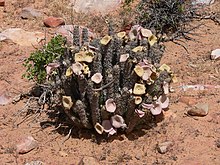Hoodia
| Hoodia | |
|---|---|
 |
|
| Hoodia gordonii | |
| Scientific classification | |
| Kingdom: | Plantae |
| (unranked): | Angiosperms |
| (unranked): | Eudicots |
| (unranked): | Asterids |
| Order: | Gentianales |
| Family: | Apocynaceae |
| Subfamily: | Asclepiadoideae |
| Tribe: | Stapeliae |
| Genus: |
Hoodia Sweet ex Decne. |
Hoodia /ˈhʊdiːə/ is a genus of flowering plants in the family Apocynaceae, under the subfamily Asclepiadoideae, native to Southern Africa. They are stem succulents, described as "cactiform" because of their remarkable similarity to the unrelated cactus family. They can reach up to 1 m high and have large flowers, often with a tan colour and strong smell. The group was first described as a genus in 1844. In 2006, the genus became internationally known and threatened by collectors, after a marketing campaign falsely claiming that it was an appetite suppressant for weight loss.
Hoodia gordonii is traditionally used by the San people (Bushmen) of the Namib desert as an appetite suppressant as part of their indigenous knowledge about survival in the harsh desert conditions. In a well-known case of biopiracy, bioprospectors from South Africa’s Council for Scientific and Industrial Research (CSIR) realized that the plant was marketable and patented its use as an appetite suppressant without recognizing the Sans' traditional claims to the knowledge of the plant and its uses. The patent was later sold to Unilever, which marketed hoodia products as diet supplements. In 2003, the South African San Council made an agreement with CSIR in which they would receive from 6 to 8% of the revenue from the sale of Ho. gordonii products, money which would be deposited in a fund to purchase land for the San people who had been dispossessed from their lands by white settlers.
...
Wikipedia
